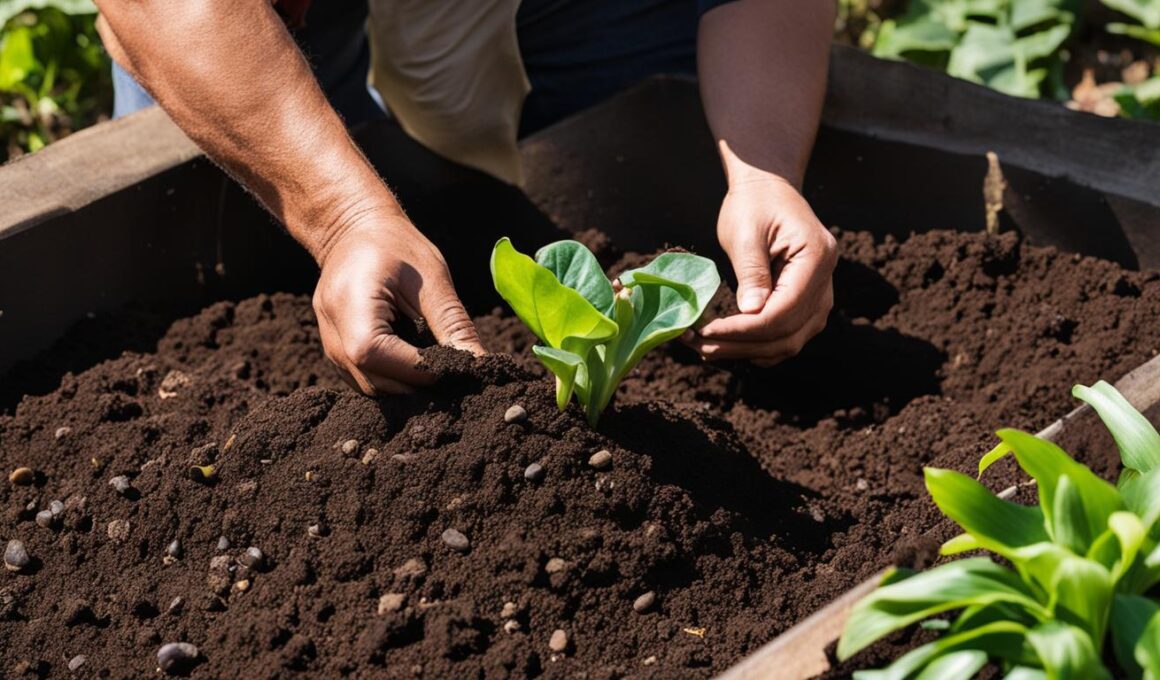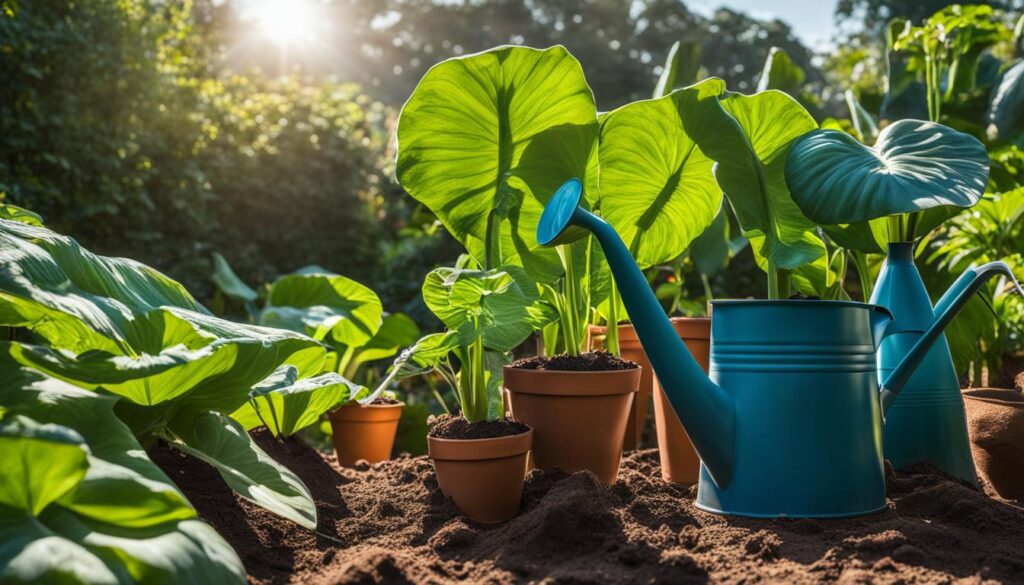Welcome to our guide on planting elephant ear bulbs! If you’re looking to add a touch of tropical beauty to your garden, planting elephant ears is a fantastic choice. These plants, also known as colocasia and alocasia, are prized for their large, dramatic foliage that brings a bold and exotic look to any landscape. In this article, we’ll walk you through the optimal time to plant elephant ears to ensure their successful growth and vibrant display in your garden.
When it comes to planting elephant ear bulbs, timing is crucial. Ideally, you should plant the bulbs in the spring once all signs of frost have passed. These plants thrive in warm weather, so it’s essential to wait until the soil temperature reaches around 65ºF (18ºC) before planting.
Elephant ear bulbs require warmth to sprout and grow, as they are native to tropical climates. If you live in a colder climate, you can start the planting process indoors and transfer the bulbs outside once the threat of frost has subsided. This way, you can enjoy the lush foliage of these plants even in regions with shorter growing seasons.
Once planted, elephant ears usually take between 3 to 8 weeks to sprout, with faster growth occurring in warmer climates. It’s important to provide regular watering, aiming for approximately 2-3 inches (5-8 cm) of water per week. Additionally, monthly fertilization with a general fertilizer will help ensure healthy growth and vibrant foliage.
In zones 7-11, where winter temperatures are milder, you can leave the elephant ears in the ground and cover the soil for winter protection. However, if you live in colder zones, it’s best to dig up the bulbs in the fall if you want to save them for the next spring. Elephant ears are hardy in zones 9-11 and won’t survive freezing temperatures in other zones.
To winterize elephant ears in colder climates, cut the stems after the first frost, and carefully dig up the tubers. Store them in a cool, dark place, such as a basement or garage, and cover them with peat moss and soil to keep them dormant until the next planting season.
Remember, elephant ears are toxic to dogs, so be sure to keep them away from your furry friends. With the proper planting and care, you’ll be rewarded with stunning, tropical foliage that adds a touch of exotic beauty to your garden. Now let’s explore how to plant elephant ear bulbs in more detail!
How to Plant Elephant Ear Bulbs
Planting elephant ear bulbs requires proper technique to ensure healthy growth. Here are the steps to follow:
- Choose the right timing: Plant elephant ear bulbs when the soil warms up in the spring and after any danger of frost has passed. This typically occurs once all signs of frost are gone and the soil temperature reaches 65ºF.
- Select the perfect spot: Find a partially shaded location or an area with filtered sunlight for your elephant ear bulbs. This will provide the ideal light conditions for their growth.
- Give them room to thrive: Elephant ear plants require ample space to spread their large leaves. Make sure to allow at least three feet of space for proper growth.
- Prepare the hole: Dig a hole that is three to four times the size of the tuber. The hole should be deep enough to accommodate the tuber with the pointed side up, and the top of the tuber should be about one to two inches below ground level.
- Fill with loose soil: Refill the hole with loose soil, ensuring that the tuber is adequately covered. Leave about one to two inches of soil above the tuber.
- Water thoroughly: After planting, water the area deeply to settle the soil and provide moisture to the tuber. Aim to have one to two inches of soil covering the tuber after watering.
- Mark the location: It may take some time for the first signs of sprouting to appear, which can range from two to eight weeks. To keep track of where you planted the tuber, mark the location.
- Container planting: If you prefer, you can also plant elephant ear bulbs in containers. However, in colder climates, it is recommended to dig up the tubers and store them in a cool, dry place for winter protection.
With these planting steps, you can ensure that your elephant ear bulbs have the best start for vibrant and healthy growth.
How to Care for Elephant Ears
To keep your elephant ear plants healthy and thriving, it’s important to provide them with proper care and attention. Follow these care tips to ensure the optimal growth and longevity of your elephant ear plants.
Consistent Moisture
Elephant ears require consistent moisture, especially during the summer months. Make sure to water them frequently and avoid letting the soil dry out completely. One way to determine if your plants need water is by checking the leaves. If they become droopy, it’s a sign that the plant is thirsty and needs watering.
Nutrient Boost
Supply your elephant ear plants with additional nutrients by applying liquid fertilizer every two to three weeks. This will provide them with the essential nutrients they need for healthy growth. Choose a balanced fertilizer suitable for tropical plants and follow the instructions on the label for proper application.
Trimming Faded Leaves
To encourage new growth and maintain the aesthetic appeal of your elephant ear plants, it’s important to trim away any faded or brown leaves. This will not only improve the overall appearance of the plants but also direct energy towards developing new healthy leaves.
Winter Care
In regions with zones 9-11, you can leave your elephant ear plants in the ground during the winter months. However, it’s important to cover the soil with a layer of mulch or protective material to shield the plants from harsh weather conditions.
If you live in colder zones, it’s necessary to dig up the tubers before the temperature drops. Store the tubers indoors in a cool and dark place to protect them from frost. Make sure to check on them periodically and discard any damaged or rotting tubers.
Indoor Growing
Elephant ears can also be grown indoors as houseplants if provided with adequate sunlight and water. Place your potted elephant ears near a bright window where they can receive indirect sunlight for several hours each day. Water them regularly, ensuring the soil is consistently moist but not waterlogged.
By following these elephant ear care tips, you can maintain healthy and vibrant plants that will add a touch of tropical beauty to your garden or indoor space.
Conclusion
Elephant ears, or colocasia and alocasia plants, are highly sought after for their stunning, tropical foliage. To successfully grow elephant ear plants, start by planting the bulbs in the spring once the threat of frost has passed and the soil has warmed up to 65ºF. Choose a partially shaded location that offers protection from direct sunlight. Ensure that the soil is rich and well-draining to promote optimal growth.
Proper watering is crucial for the health of elephant ear plants. Keep the soil moist by watering frequently, aiming for approximately 2-3 inches of water per week. In addition to regular watering, provide the plants with liquid fertilizer every few weeks to supply them with essential nutrients for vigorous growth.
If you live in a colder climate, it’s necessary to take extra precautions to protect elephant ear plants during the winter months. In the fall, dig up the tubers before the temperature drops. Store them in a cool, dry place, such as a basement or garage, to ensure their survival. It’s important to keep the tubers dormant during this period. Come spring, you can replant them for another season of beautiful foliage.
Elephant ears are versatile plants that can be grown in various settings. They can be cultivated in containers, making them an excellent choice for apartments, balconies, or patios. Additionally, they can be kept as houseplants, bringing a touch of the tropics indoors. By following the proper planting and care techniques, you’ll be able to enjoy the lush, dramatic foliage of elephant ear plants in your garden or indoor space.
Can I Plant Elephant Ear Bulbs During the Same Season as When Lemons Are In Season?
Yes, you can plant elephant ear bulbs during the same season as when lemons are in season. The seasonal availability of lemons typically occurs in the summer, which is a great time to plant elephant ear bulbs as well. Both plants thrive in warm, sunny conditions, making them compatible for simultaneous planting.









